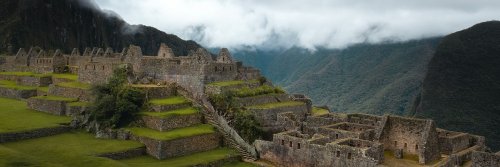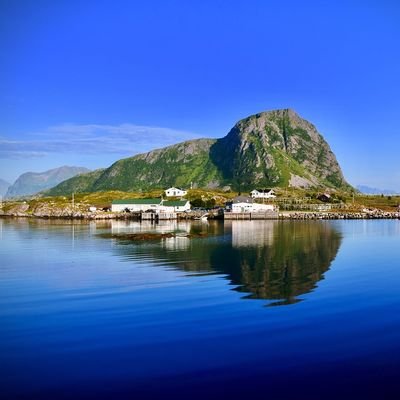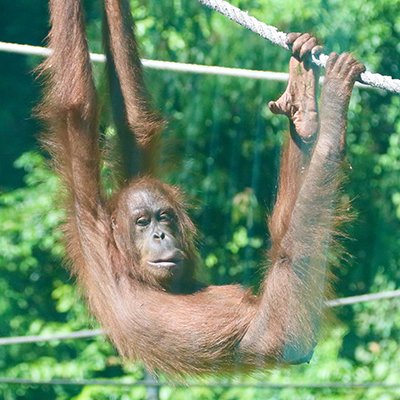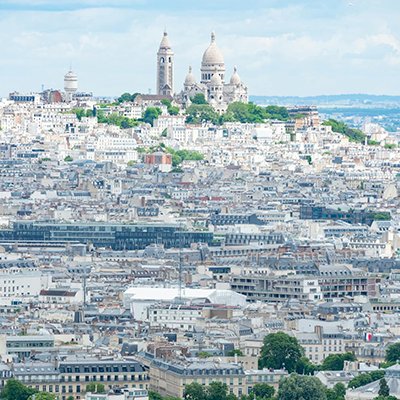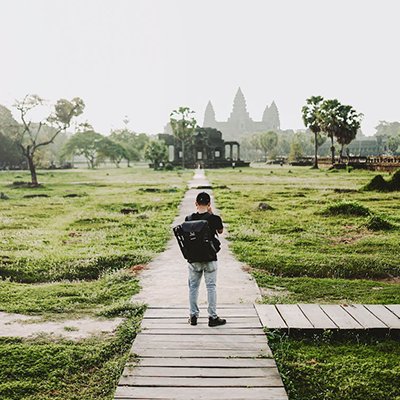Old Mountain
On misty mornings Machu Picchu seems to float among the clouds. This masterpiece of architecture and landscaping is situated 2,430 meters, or 7,970 feet, above sea level. The site may be secluded high in the Peruvian Andes, but the required trek is an important part of the experience, adding to the intrigue and excitement. The profound impression it leaves on visitors lasts a lifetime.

History
The sacred Inca fortress is believed to have been built around the year 1450. Around the time of Spanish conquest, in the early 16th century, the city was abandoned. It was never completely lost or forgotten by the locals, but was “re-discovered” in 1911 by Hiram Bingham, an American historian and Yale University professor. He was led to the site by Melchor Arteaga, a Qechua speaking local. In the following years, the well preserved site was excavated. The study of the site’s unique features continues to the present day.
The purpose and utility of Machu Picchu is still debated by historians. Some believe it serves as a mausoleum for Incan King Pachacutec and others claim that it was a governmental and agricultural zone. It’s possible that it was a vital resting place for travelers journeying from the Andes to the Amazon. Perhaps it was a spiritual gathering site, used for ceremonies and religious rites. All of these theories seem true to some degree, yet the discussion continues and may never be officially put to rest.
The splendidly designed city had a population of up to a thousand people at a given time. This community included descendents of Pachacutec, religious officials, skilled artisans and laborers. Unearthed human remains indicate the population of Machu Picchu were of diverse backgrounds. Specially constructed terraces were used for growing staple crops like corn and potatoes. These incredible achievements of engineering would not have been possible without the Inca’s innate ability to incorporate their natural environment into every aspect of daily life. The rugged terrain was tamed and respected. This alluring harmony of man made civilization and the surrounding wilderness is what draws in thousands of tourists every year.

Cultural Significance
Machu Picchu became a UNESCO World Heritage Site in 1983 and was voted as one of the new seven wonders of the world in 2007. The ancient city is the driving economic force behind Peru’s prosperous tourism industry. The granite structures and terraces illustrate technical manipulation and adept cooperation with the natural environment at the height of the Inca empire. It also demonstrates their advanced engineering skills, the likes of which can’t be duplicated today. The spiritual, imperial and cultural reach of the Inca are alive today in these mountains, stones and forests.
Visiting the Site
It will take some planning and an adventurous spirit to reach the famed city. But trust that along the way, the sights, sounds and experiences are sure to strike awe and inspire.
The city of Cuzco, an enchanting place in its own right, is the gateway to many of Peru’s tourist destinations. No doubt it will be the starting point for your journey to Machu Picchu. Travel by bus or train from Cuzco to Ollantaytambo. On the ride you’ll hurdle over hills that showcase stunning views of the Sacred Valley.

The old city of Pisac is a convenient stop along the route. Visit their large market that offers handmade jewelry, art and clothing of alpaca wool and carry on to the ruins at Ollantaytambo. The impressive remnants of the city are an ideal warm up for the sights at Machu Picchu.
On the train, try your best to get a riverside window seat and marvel at the unique flora and fauna around the Urubamba River.
Aguas Calientes, the small town at the base of the mountain, is the last stop before the final ascent to the citadel in the sky. Spend the night here to get a critical early start on the journey. Take the bus, a 20-30 minute zig-zagging ride up the mountain, or pick up the Camino Peatonal Trail and rough it for a strenuous 2-3 hour hike.
Finally, the hallowed sanctuary of Machu Picchu should be left to speak for itself, aside from a few parting bits of advice:
It’s a pleasure to tour with a guide to gain historical insights and learn about current updates to the grounds; plus you’ll have someone to snap photos at every scenic spot.
Ahead of time, purchase a ticket for the hike up Huayna Picchu. The incredibly steep and intimidating hike provides breathtaking views overlooking the entire city of Machu Picchu.
And most important of all, take your time to enjoy the grounds and let the energy of the space inspire you.
A Curious Conclusion
The feat of building an entire mountain retreat of massive, precisely cut stone is beyond mystifying. Like the Pyramids at Giza, and other ancient archaeological sites, Machu Picchu’s construction and function remain an unsolved mystery. How did their building skills come to be so advanced? Where did these people and their knowledge disappear to? The sense of enigmatic sanctity allures tourists, travelers, adventurers and spiritual seekers all to wonder at the grandeur of the ancient Inca city.
Aaron Walker is a farmer, writer and English tutor, grounded in an agricultural lifestyle dictated by the seasons. Bound by deep roots to his native New England, he is still often compelled to hit the open road to enjoy life’s endless journey. Contact him here Fiverr Freelance Writer or hereItalki English Tutor.

